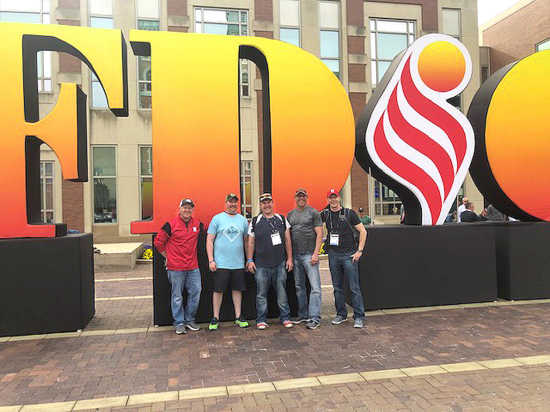Modern construction offers new challenges for firefighters

INDIANAPOLIS, Ind. Because today's new structures contain "fuels" that burn hotter and faster, firefighters have to employ new tactics and think differently to fight today's fires.
In April, in Indianapolis, City of McCook firefighters attended intensive Fire Department Instructors Conference (FDIC) training to keep them current on new "enemies" and new strategies to conquer them.
"McCook residents expect us to protect them to show up and be competent," said firefighter Shane Smith. "We have to be aggressive, and smart."
The building is the firefighter's enemy, and fire is the weapon it uses: This could be the firefighter's new philosophy, according to McCook firefighters Shane Smith and Rick Metcalf.
Think about it. New construction uses lots of particle board and glue, homes are bigger and many new homes are designed with "open concepts." Press-board is a quickly-consumed fuel, larger homes provide more air to feed fires and open concepts have no walls to slow the progression of fire, heat and smoke.
Even in older structures, newer furniture and carpets contain synthetics; plastics have replaced natural materials like wood, cotton and paper throughout the house. Synthetics and plastics result in faster-developing, much hotter fires.
Shane explained recently, "While it used to take a room 25-30 minutes to flashover ("flashover" is the nearly-simultaneous ignition of ordinary combustible materials, at normally 932-1,100 degrees F, in an enclosed area; a fire spreading very rapidly across a gap because of intense heat), now it's only about five minutes before a room flashes."
In a burning room, ceiling temperatures that may have been 1,000 to 1,200 degrees in the past are now easily rising to 1,800 to 2,000 degrees.
Rick said, "No one survives flashover no one."
Because the temperature of a burning room can rise so much higher and so much quicker, properly geared-up firefighters can use a 2 1/2-gallon fire extinguisher at the same time the big supply hoses are hooking up to hydrants and the smaller water lines are coming off the fire trucks.
Short bursts of water out of a fire extinguisher can lower the temperature of the room by 800 degrees, Shane said. "This is exciting. We'll start training on this this is a change we'll be making."
Both Shane and Rick were impressed with the training they received in Indianapolis, and what they can bring back to McCook's firefighters.
"We can read about it, and we can watch videos," Shane said, but nothing can compare to the in-depth and hands-on training they get from instructors gathered in Indianapolis from all over the country, from large fire departments. "We're training with people who are called to possibly five working fires a shift. In McCook, we see, on average, five working fires a year."
"What we learn in Indianapolis and bring back to McCook is phenomenal," Shane said. "We're already implementing changes, and planning trainings."
And, he said, they have the phone numbers of all the instructors. "They're always accessible," Shane said. "It truly is about sharing the knowledge instructors sharing theirs with us, and us bringing it back to our own firefighters."
Classes that McCook firefighters attended included building construction, critical action for first arrivers on the scene, ventilation, enter and search, active shooters, the use of nozzles that deliver almost twice as much water to absorb the BTUs of todays fires, extrication, communication, engine company operations, saws and their implementation, and working in the "flow path" of a fire.
"Door control" is one of Shane's missions: "'Close before you doze'," he said.
Closing bedroom doors at night must become as habitual as brushing your teeth and putting on your PJ's.
In case of a fire, a closed door can isolate the fire's flow to inside or outside the room. Inside a room, a closed door can reduce smoke and room temperature and keep carbon monoxide levels down.
A closed bedroom door can also give whoever's inside more time to react when the smoke alarm goes off.
Because of highly flammable materials in furniture and home construction and the contemporary trend toward open concept floor plants, the average time to escape a house fire has gone from 17 minutes to three minutes or less.
Knowing this, firefighters strongly believe that teaching "Close before you doze" is just as important as teaching "Stop, drop and roll."
Rick explained another concept and firefighter's credo they've learned: "The Rule of 3. In a stressful event, you can remember three things. Trying to remember to do more than three things, performance drops off and skills are forgotten."
He added, with a grin, "That's why we have zippers in our boots, not laces "
